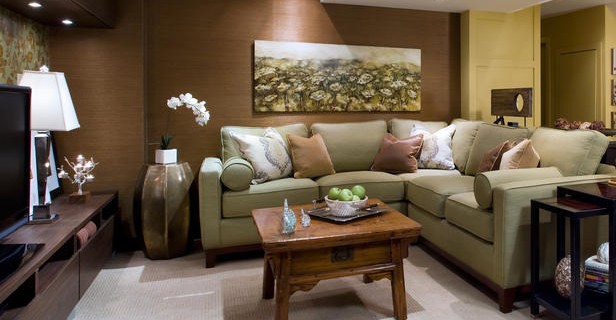A finished basement provides a canvas of possibilities when it comes to color. Should you use colors from the rest of the house in the basement to give your home a cohesive look? Or should you utilize colors completely opposite of the rest of your home to define the basement as its own space? Deciding what color to paint your basement boils down to three factors: the size of the space, what you’ll be using the area for, and the type of lighting your basement has.
Size: Is your basement large, spanning most of your home, or is it small with just one finished room and a storage area? A small sized basement can feel even smaller when painted with rich, dark colors. If you want your basement to feel more open and spacious, paint with cool-toned colors such as pale blue or gray. Cool neutrals will make a space feel larger and appeal to prospective buyers if ever you were to sell your home. By contrast, a large basement easily allows for a range of colors to be used. Painting a large basement a dark color can make it look cavernous, so you may want to consider trim work or an accent wall to maintain a feeling of spaciousness.
Purpose: What function will the basement serve? Will you convert it into an extra guest space, a living space, a play room, or a home gym? Guest rooms and home gyms tend to feel cramped with dark colors, so light colors such as ivory, daffodil yellow, or pale blue would keep the space open, making guests feel welcome and energized. For a cozy living space, choose dark, warm colors like rust red or chocolate brown. If your basement has separate areas for entertaining, paint one wall an accent color to define that area. Just be sure that the tones of the colors you use are uniform!
Lighting: How much natural light reaches your basement, if any? Windows and lighting should always be considered when choosing wall color for your basement. If natural light is available, paint the wall closest to the window a bright color. The natural light will brighten the space when reflected off a bright wall like burnt orange or a shade of lavender. If natural light isn’t available, work with beige or dark neutrals to achieve a war, open space. Use bright indoor lighting to allow dark colors, such as navy and brown, to create a dramatic and stunning space.
The thought of working with a blank slate can be daunting, but asking the right questions will lead you to an easy answer. Consider the basement size, purpose and lighting before choosing colors. Once you have established those parameters, work with colors you are comfortable with! If you’re still stuck on color options, contact the color experts at CertaPro Painters of Reading by calling 610-488-6560.





